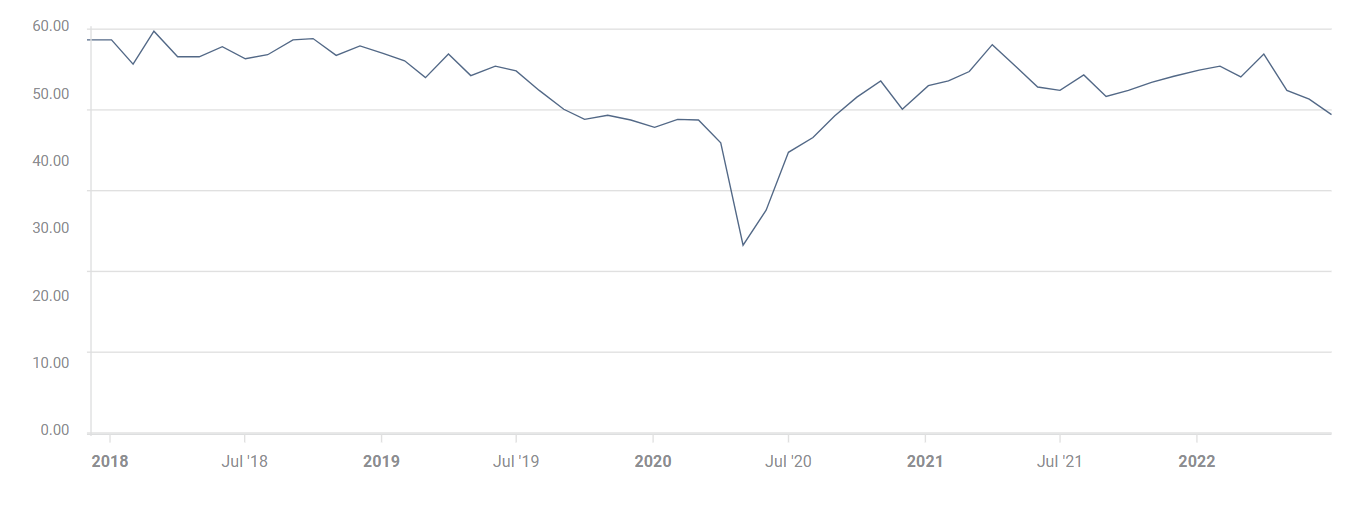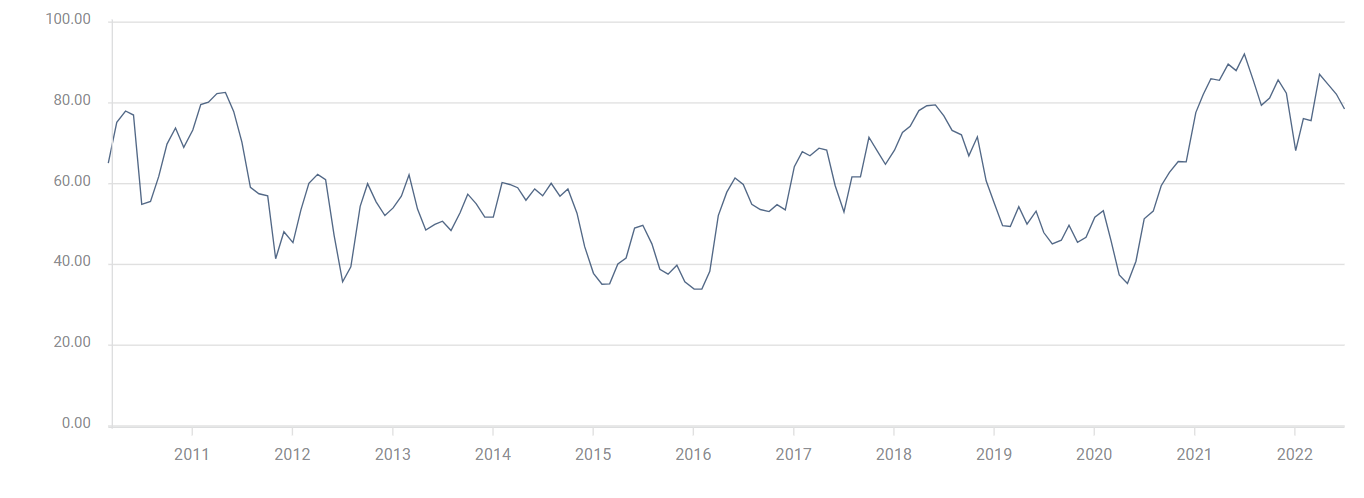- The ISM Manufacturing PMI consists of employment and inflation components, eyed by the central bank.
- Markets are rethinking assumptions about Fed dovishness and weak economy.
- The dollar is set to kick off the new months with an upswing.
When will inflation reach its peak? That question has returned to the forefront now that the recession discussion has been relegated to politics. Markets only care about the Federal Reserve's next moves -- and every piece of data counts. Here is why I think the ISM Manufacturing Purchasing Managers' Index is set to boost the dollar.
This forward-looking business survey used to be a critical leading indicator for Nonfarm Payrolls. It remains significant, and any further drop in this sub-component would be worrying, pointing a downturn in hiring in the industrial sector. Back in June, it extended its drop under 50, the threshold separating expansion and contraction.
Source: FXStreet
If the employment component nears 40, investors would see the labor market as cooling fast, implying fewer rate hikes would be needed from the Fed. However, the labor market plays second fiddle to inflation.
The Fed is fully focused on its price stability mandate, much more than employment. By pointing to the Employment Cost Index as a critical figure, Fed Chair Jerome Powell hinted he would like to see further cooling. A lower shortage of workers would help bring inflation down.
Therefore, the Prices Paid component in the ISM Manufacturing PMI is even more important and remains sky high. Despite dropping to 78.5 points in June, the indicator is at extremely high levels -- and projected to climb back to 81.
I have no reason to believe it will beat nor miss expectations, but I can say that even if it only holds above 75, it would indicate that price pressures are elevated.
Moreover, Americans have been shifting back from buying consumer goods such as Pelotons and cookware to purchasing experiences such as flights or restaurants. Walmart is stuck with big inventories while airport queues are lengthening. That pendulum swing back from goods to services should hurt the manufacturing sector -- and also lower prices. If inflation in this sector remains well above historic norms, it would indicate that price pressures for services are even higher.
While the Gross Domestic Product (GDP) is negative, price pressures remain elevated, as seen by the better-than-expected Employment Cost Index (ECI) at 1.3%, and the Core Personal Consumption Expenditure (Core PCE) at 4.8%. Both figures sent the dollar up, as they represent inflation. I see this as a sign of what is important.
All in all, if the inflation component remains high, it would likely push the dollar up. Only a substantial drop in the inflation component and a weak employment one would send the dollar down.
Final thoughts
The ISM Manufacturing PMI will be eyed for signs that inflation is falling, but the chances of a substantial improvement are low. In this scenario, the dollar has room to rise.
Information on these pages contains forward-looking statements that involve risks and uncertainties. Markets and instruments profiled on this page are for informational purposes only and should not in any way come across as a recommendation to buy or sell in these assets. You should do your own thorough research before making any investment decisions. FXStreet does not in any way guarantee that this information is free from mistakes, errors, or material misstatements. It also does not guarantee that this information is of a timely nature. Investing in Open Markets involves a great deal of risk, including the loss of all or a portion of your investment, as well as emotional distress. All risks, losses and costs associated with investing, including total loss of principal, are your responsibility. The views and opinions expressed in this article are those of the authors and do not necessarily reflect the official policy or position of FXStreet nor its advertisers. The author will not be held responsible for information that is found at the end of links posted on this page.
If not otherwise explicitly mentioned in the body of the article, at the time of writing, the author has no position in any stock mentioned in this article and no business relationship with any company mentioned. The author has not received compensation for writing this article, other than from FXStreet.
FXStreet and the author do not provide personalized recommendations. The author makes no representations as to the accuracy, completeness, or suitability of this information. FXStreet and the author will not be liable for any errors, omissions or any losses, injuries or damages arising from this information and its display or use. Errors and omissions excepted.
The author and FXStreet are not registered investment advisors and nothing in this article is intended to be investment advice.
Recommended Content
Editors’ Picks
EUR/USD clings to gains near 1.0700, awaits key US data

EUR/USD clings to gains near the 1.0700 level in early Europe on Thursday. Renewed US Dollar weakness offsets the risk-off market environment, supporting the pair ahead of the key US GDP and PCE inflation data.
USD/JPY keeps pushing higher, eyes 156.00 ahead of US GDP data

USD/JPY keeps breaking into its highest chart territory since June of 1990 early Thursday, recapturing 155.50 for the first time in 34 years as the Japanese Yen remains vulnerable, despite looming intervention risks. The focus shifts to Thursday's US GDP report and the BoJ decision on Friday.
Gold closes below key $2,318 support, US GDP holds the key

Gold price is breathing a sigh of relief early Thursday after testing offers near $2,315 once again. Broad risk-aversion seems to be helping Gold find a floor, as traders refrain from placing any fresh directional bets on the bright metal ahead of the preliminary reading of the US first-quarter GDP due later on Thursday.
Injective price weakness persists despite over 5.9 million INJ tokens burned

Injective price is trading with a bearish bias, stuck in the lower section of the market range. The bearish outlook abounds despite the network's deflationary efforts to pump the price.
Meta takes a guidance slide amidst the battle between yields and earnings

Meta's disappointing outlook cast doubt on whether the market's enthusiasm for artificial intelligence. Investors now brace for significant macroeconomic challenges ahead, particularly with the release of first-quarter GDP data.

